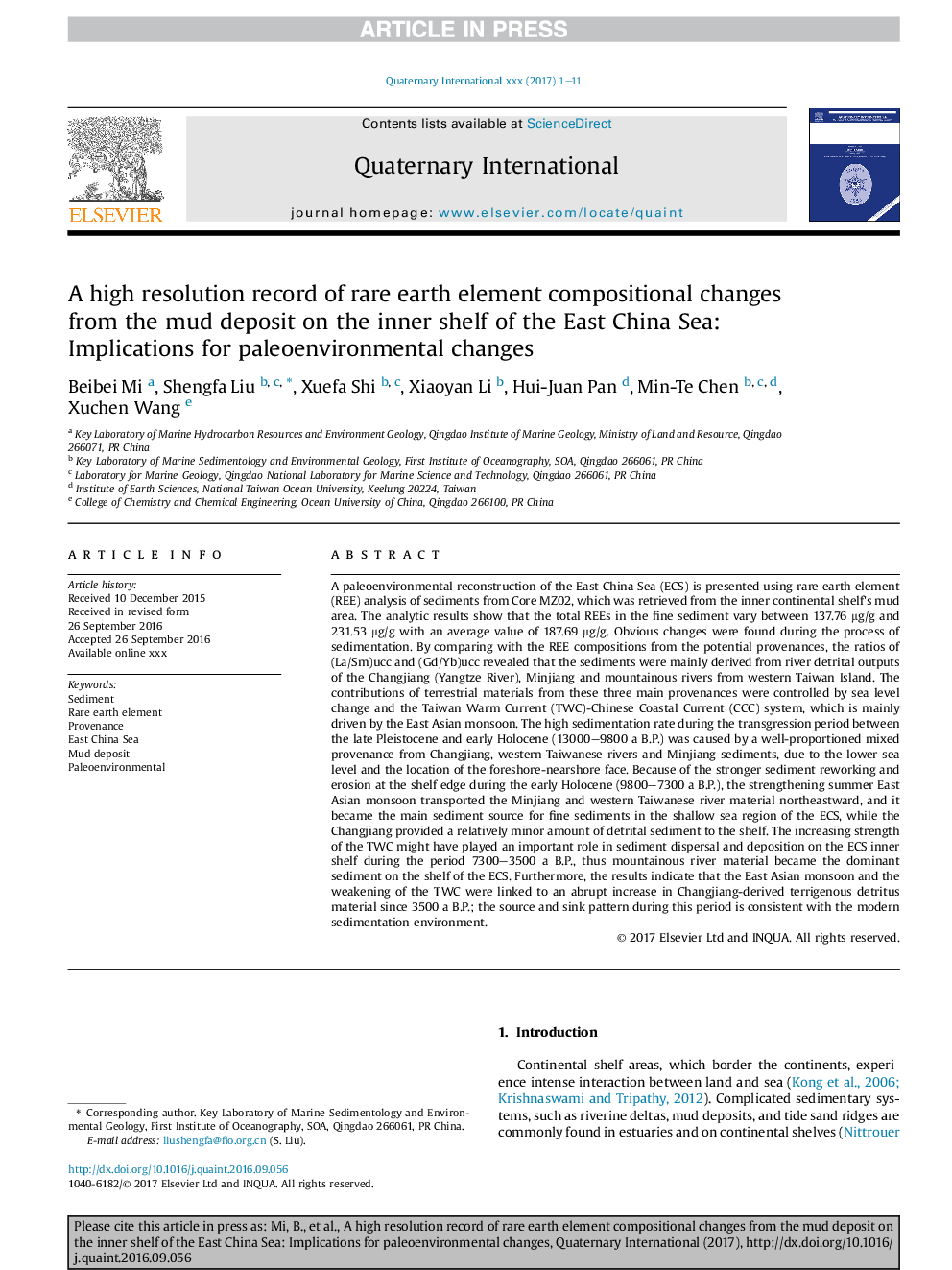| کد مقاله | کد نشریه | سال انتشار | مقاله انگلیسی | نسخه تمام متن |
|---|---|---|---|---|
| 5113108 | 1484076 | 2017 | 11 صفحه PDF | دانلود رایگان |
عنوان انگلیسی مقاله ISI
A high resolution record of rare earth element compositional changes from the mud deposit on the inner shelf of the East China Sea: Implications for paleoenvironmental changes
ترجمه فارسی عنوان
رکورد با وضوح بالای تغییرات ترکیبات عناصر کمیاب خاکی از ذخیره گلی در قفسه داخلی دریای چین شرقی: پیامدهای تغییرات محیطی پائولو
دانلود مقاله + سفارش ترجمه
دانلود مقاله ISI انگلیسی
رایگان برای ایرانیان
کلمات کلیدی
موضوعات مرتبط
مهندسی و علوم پایه
علوم زمین و سیارات
زمین شناسی
چکیده انگلیسی
A paleoenvironmental reconstruction of the East China Sea (ECS) is presented using rare earth element (REE) analysis of sediments from Core MZ02, which was retrieved from the inner continental shelf's mud area. The analytic results show that the total REEs in the fine sediment vary between 137.76 μg/g and 231.53 μg/g with an average value of 187.69 μg/g. Obvious changes were found during the process of sedimentation. By comparing with the REE compositions from the potential provenances, the ratios of (La/Sm)ucc and (Gd/Yb)ucc revealed that the sediments were mainly derived from river detrital outputs of the Changjiang (Yangtze River), Minjiang and mountainous rivers from western Taiwan Island. The contributions of terrestrial materials from these three main provenances were controlled by sea level change and the Taiwan Warm Current (TWC)-Chinese Coastal Current (CCC) system, which is mainly driven by the East Asian monsoon. The high sedimentation rate during the transgression period between the late Pleistocene and early Holocene (13000-9800 a B.P.) was caused by a well-proportioned mixed provenance from Changjiang, western Taiwanese rivers and Minjiang sediments, due to the lower sea level and the location of the foreshore-nearshore face. Because of the stronger sediment reworking and erosion at the shelf edge during the early Holocene (9800-7300 a B.P.), the strengthening summer East Asian monsoon transported the Minjiang and western Taiwanese river material northeastward, and it became the main sediment source for fine sediments in the shallow sea region of the ECS, while the Changjiang provided a relatively minor amount of detrital sediment to the shelf. The increasing strength of the TWC might have played an important role in sediment dispersal and deposition on the ECS inner shelf during the period 7300-3500 a B.P., thus mountainous river material became the dominant sediment on the shelf of the ECS. Furthermore, the results indicate that the East Asian monsoon and the weakening of the TWC were linked to an abrupt increase in Changjiang-derived terrigenous detritus material since 3500 a B.P.; the source and sink pattern during this period is consistent with the modern sedimentation environment.
ناشر
Database: Elsevier - ScienceDirect (ساینس دایرکت)
Journal: Quaternary International - Volume 447, 15 August 2017, Pages 35-45
Journal: Quaternary International - Volume 447, 15 August 2017, Pages 35-45
نویسندگان
Beibei Mi, Shengfa Liu, Xuefa Shi, Xiaoyan Li, Hui-Juan Pan, Min-Te Chen, Xuchen Wang,
